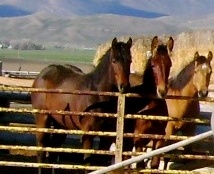 I have always been a non-confrontational person. And believe it or not, it carries over to how I deal with horses, too. It’s not that horses scare me or that I’m afraid to push my luck or take chances around them. I grew up with horses and I’ve never been seriously hurt by a horse, so I’ve never had any fear to overcome. But I have seen horses get hurt in bad situations, and spent subsequent years thinking of what I could have done differently that might have prevented their injury, and it makes me cautious and more respectful when handling them.
I have always been a non-confrontational person. And believe it or not, it carries over to how I deal with horses, too. It’s not that horses scare me or that I’m afraid to push my luck or take chances around them. I grew up with horses and I’ve never been seriously hurt by a horse, so I’ve never had any fear to overcome. But I have seen horses get hurt in bad situations, and spent subsequent years thinking of what I could have done differently that might have prevented their injury, and it makes me cautious and more respectful when handling them.
I’ve been thinking about this a lot lately, because I spent almost a week at my folks’ place recently, and my younger sister and I were working with the yearling bunch, and this issue came up.
There was a buckskin filly named Donegal that they had raised, and she just didn’t like being caught or handled. Other than her initial imprint training at birth and later being weaned from her mother, she hadn’t really been handled much. She needed to be caught, haltered, tied, and her feet trimmed. I picked her to work with, because my sister Karmen had her own filly she wanted to train.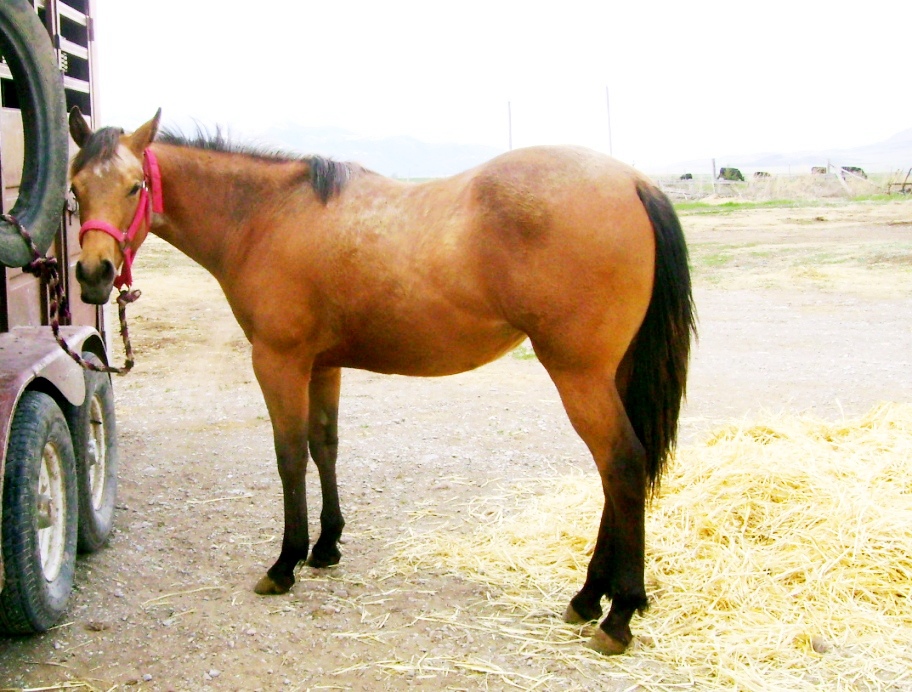 Docs Donegal, yearling AQHA filly.
Docs Donegal, yearling AQHA filly.
Her filly was a leggy brown girl named Tally that she had purchased last summer at a production sale. Tally seemed trusting, mature for her age, easy to catch and handle, and generally sweet-tempered. But all four feet were badly grown out, and needed trimmed and shaped up. So we had our work cut out for us.
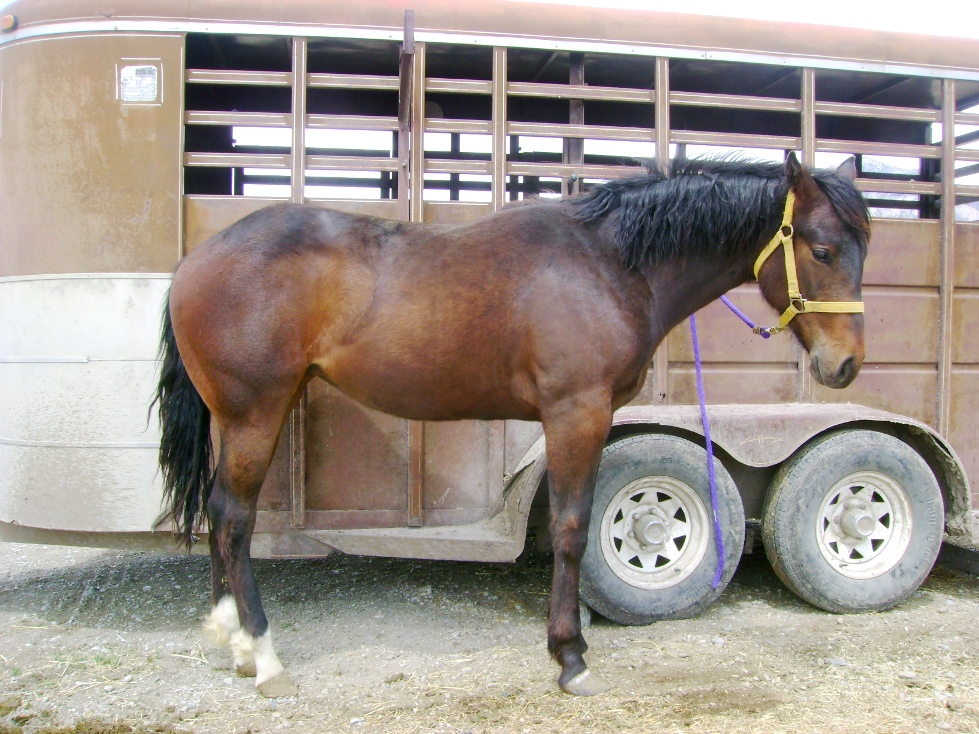 Karmen’s AQHA brown yearling filly, Hancocks Tallyho.
Karmen’s AQHA brown yearling filly, Hancocks Tallyho.
My first task was to catch Donegal, while Karmen tied up Tally and her ornery mule filly Garnet. Donegal liked to come up and sniff your hand for treats, then whirl and run away snorting if you tried to touch her or halter her. Once the other two fillies were led out of her pen, she started thinking a little more productively. I cornered her and started working on getting my hands on her. Her body language told me that she wasn’t at all frightened, she just wanted to stay in charge of herself and not let me get a halter on her.
Since they didn’t have a round pen, I used some of the same principles of join up just to get her to look at me and stand for me touching her. If she dodged and ran away, I followed her aggressively until she stopped, and then if she would look at me or turn towards me, I would back up a step from her and speak kindly to her, reaching out a gentle hand to touch her. She was smart and watchful, and badly wanted to join the other two fillies outside the pen, so it wasn’t long before she would let me stand on her right side and pet all along her neck and back.
Then I was able to lower the halter under her neck, flip the strap up and over, and buckle it on the other side, all while standing on her right. It just seemed more comfortable for her to let me be on the off side, so I adapted to putting the halter on that way, even though it was harder. It saved me the trouble of chasing her around some more and working to get on her left side.
Then I led her out and tied her to an inner tube secured to the horse trailer, since she hadn’t been tied before then and the inner tube would have some stretch and “give” in it to get her used to the idea. I would have preferred to tie them in the barn to sturdy posts, as the trailer seemed unsafe with its corners and edges and wheels in reach of their dainty little legs. But since they weren’t my horses, I was following my sister’s directions.
We brushed them and petted them as they stood tied, and Donegal never really tested the rope. She was happy to stand and check out the trailer, licking it, nipping, and playing with her lead rope. We let them stand awhile, to get them used to being tied and standing still, and they all did very well with the assignment.
I wanted to trim just the fronts on Donegal, and I figured it would be easier and more comfortable for her to go back in her pen and eat hay from the feeder as I worked on her hooves. So I led her back in and started working to get her used to having her legs touched. Every time I put a hand on her leg, she wanted to move it…either stepping away or picking it up quickly. And she didn’t want me to hold it, she would put weight on it and bow down to the ground, like she couldn’t stand up on three legs, she wanted to just lie down if I held her foot. So I kept working to get her to stand with me touching the leg. After she got more comfortable with that, it was very easy to hold it up, because she was very good at picking it up from the first…just not sure if she wanted to let me hold it. But with a little patience, she let me trim both front feet and they looked so much better afterwards!
Meanwhile, Karmen was working with her filly, and Tally was doing good at letting her pick up her feet, but didn’t like the trimming part. She was still tied to the horse trailer, and every time Karmen went to trim, Tally pulled her foot away. After a couple tries, Karmen went and got her rope contraption where a portion of old seat belt webbing with a ring on each end is fitted around the shoulder and back of the horse, and a cotton rope is run from it down to the hoof and tied up so the horse can’t get its foot down. I’ve seen horses tied up many times, but I was worried about this one because she was young and standing way too close to some dangerous edges of the horse trailer.
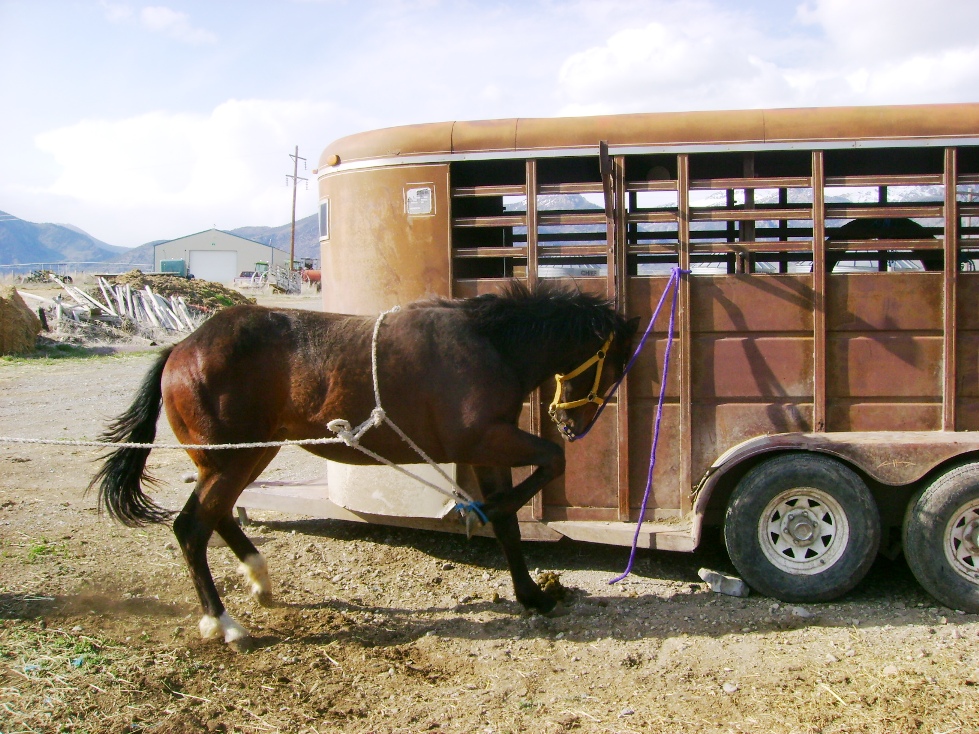
Tally fought the ropes and leaped into the air, trying to free her front foot. She banged her face on the trailer and fell down a couple of times, and each time I argued with my sister about trying a gentler way. She stubbornly said that this was what she did if she had trouble with a horse giving her its feet, and that Tally would learn that she can’t get her foot away so she’ll never try to again. So this went on for about forty minutes, and she did finally get one front foot trimmed. The filly had little dings and scratches on each of her other three legs, from jumping up and banging into the trailer. And three of her feet were still untrimmed by the time we had to put the colts away and go in for supper.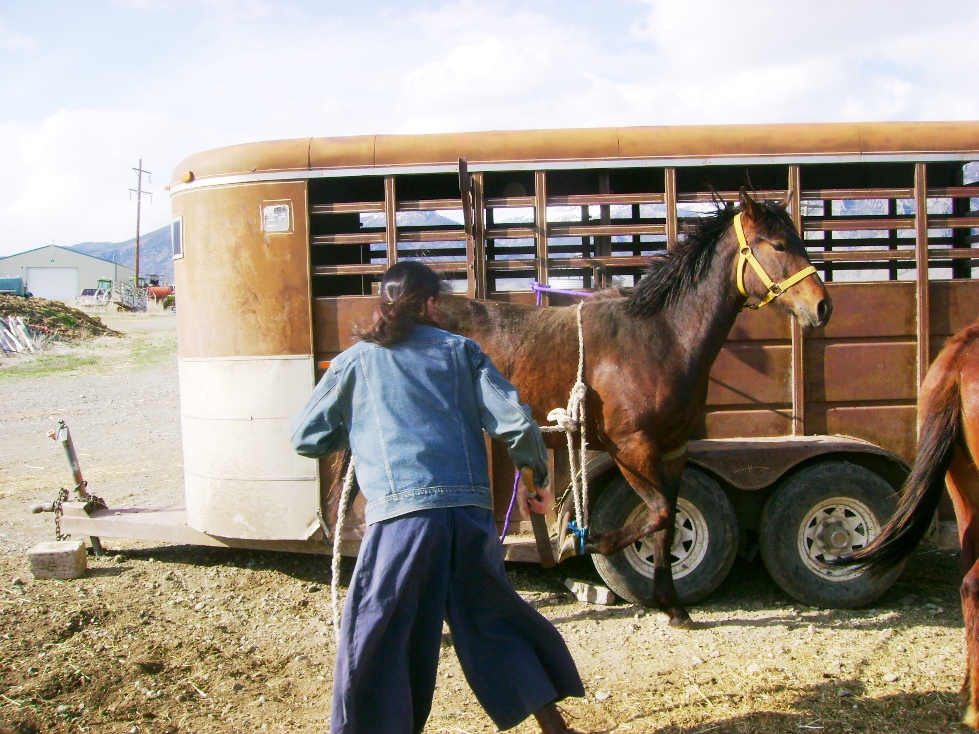
I tried to prove my point to Karmen over the supper meal. Several times while watching me work with Donegal, she would scold me for letting the filly pull her foot out of my grasp and “get away with it”. Her theory was that if a horse gets away once, he will think he can always get his own way and will have a problem with that behavior the rest of his life. I told her about an article I had read by AQHA trainer Brent Graef that disproved this theory.
He wrote in his article about trying to get his horse to cross a ditch when he was just a kid. He was riding with his mother, and was about to put the spurs to his horse to get it to cross, when his mom stopped him and told him to just let the horse stand and look at it a moment. Then she told him to ride around and find a different way across. He asked, “Won’t that make the horse think he doesn’t have to cross ditches, if I let him get away with it this time?” She said no, that horses don’t think that way. And the rest of his article reinforced that this rule just isn’t always true.
I have also heard a Tom Dorrance story from a good trainer friend of mine who knew him. He said that Tom was helping some people with their horses and they were having trouble getting a horse into the trailer. Tom told a girl to come take the horse and lead him away to a patch of grass and just let him graze awhile. Half an hour later, he took the lead rope and the horse followed him right into the trailer with absolutely no resistance.
These instances have stuck in my mind and really made me think about whether or not you should push a horse in a tough situation, or whether you should back off and risk letting it form a bad habit. I told Karmen to evaluate the two fillies we had worked with that day. Donegal started out spooky and hard to catch, but stood calmly eating at the feeder while I trimmed her hooves. Even though she pulled away a few times at the beginning, there was no heightened anxiety or fear that would stick in her memory. She also ended the day being much more comfortable with being caught, handled, and trimmed, and would most likely be much easier to work with next time.
Tally, on the other hand, had started out easygoing and gentle. When something scared her, rather than let her pull her foot away and think through the trimming process, she was tied up. Being tied up scared her and made her think she was fighting for her life. She banged her face and all three other feet on the trailer, and was holding up one hind foot at the end of the session, so she was obviously in some pain. She had learned that when she was in trouble, her handler didn’t help her out and alleviate her stress, but forced her to hold her foot up whether she wanted to or not. As a result, she still had three long feet which hurt worse now than before, and she had a worse fear of having her feet handled, because something that scary might happen the next time, too.
I’m not sure if I changed my sister’s thinking at all. We both come from very stubborn stock, and I have found before that when I share my opinions too freely, they often go in one ear and out the other. We all like to make our own choices and remain in charge of the horses we own. But I think it is a valuable thing to learn. I think you gain more if you give in to the horse sometimes, especially when a horse is truly acting out of fear and self-preservation instincts.
When you are in a leadership position with a horse and working with him through something, try not to go against the horse’s instincts. Rather, try to get those instincts to work for you to achieve your goal. If the horse would rather pick up its foot while eating comfortably, use that calming habit of eating to help you ease the horse’s fear as you introduce hoof trimming at the same time. Let the horse associate having its feet handled with basic grooming and an enjoyable session, rather than making the training more traumatic by using force. Taking away the horse’s ability to follow its own instincts makes the horse less willing to trust you.
I think in some rare instances when you have an older well-seasoned horse acting up out of sheer stubbornness, it is completely reasonable to be forceful and insist on the horse obeying your commands. But being overly forceful can do much more harm than good most of the time. Evaluate the situation and decide if you can afford to give the horse more time or choose a different action to avoid a conflict that could hurt you or your horse. Sometimes it just isn’t worth it to force the issue.
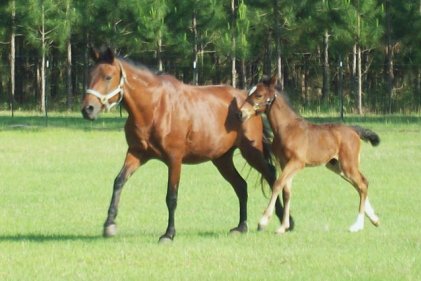

{ 6 comments }
Fear. They fight it EVERY time. I am just getting back in to horses after 20 years. I was holding my breath while reading your article, so afraid of that trailer! (and when do sisters listen to one another … LOL!)
Yes, to you and your conclusions! As my first horse-training mentor, Chris Staab, used to tell me while I was training Apache, “horses DO think things over, if you give them a chance.”
Rushing them into a panicky situation can often lead to injuries and, at best, a horse that has had a really negative experience and remembers it!
Kandra, I would love to hear more of your viewpoints on horse training! I think now, twenty years after you were trying to teach me, I’m ready to listen. I know, I used to be just as stubborn as Karmen.
I know, I used to be just as stubborn as Karmen.
I wish you, me, and our other two sisters could work together just for one week, gentling, halterbreaking, trimming hooves, and putting some first rides on two year olds out at Dad and Mom’s! How about next summer?
Margaret, yes–fortunately it didn’t turn into a fiasco with a vet call! My sister is quite a bit younger than I am, and she has a lot of “cowboy” influences out West. I try to counterbalance it a little, but she likes to do things her own way. I am happy I got to work with her that day, though–I’m still a big fan of her and her horses!
I think that it totally depends on the individual horse. My horse is 11 years old and knows his job. He needs a dominant rider and handler, one who will tell him where the boundary is always, or he will constantly test, as he is the dominant horse outside. He is a perfect gentleman around my coach (and sometimes me! I’m a softy ), who knows him inside and out, but when around some people who are more lenient work with him, he takes advantage and does stupid things, like dance around in the cross ties, neigh at his friends while being ridden, stop in the middle of the ring and spin, etc. He just knows how he can get away with things. For horses like him, I am not opposed to a “that’s rude” smack on the shoulder, or a tap with the crop while riding for correction. But it is never unwarranted, or more than the behaviour calls for.
), who knows him inside and out, but when around some people who are more lenient work with him, he takes advantage and does stupid things, like dance around in the cross ties, neigh at his friends while being ridden, stop in the middle of the ring and spin, etc. He just knows how he can get away with things. For horses like him, I am not opposed to a “that’s rude” smack on the shoulder, or a tap with the crop while riding for correction. But it is never unwarranted, or more than the behaviour calls for.
When it comes to youngsters, it is a completely different story. They are learning, and not seasoned horses who know what is expected of them. Positive reinforcement and introducing new things slowly, so that they can fully understand what they are doing. Your sister had good intentions, but I can’t help but think of the repercussions that this incident might have on this horse. This horse will probably now have a fear of trailers, and a fear of her feet being up altogether. It will most likely lead to some behavioural problems in the future. Had this horse been a 15 year old roping horse who had been there done that, then I could understand your sister’s frustration. But a new horse, new situation? Can’t say I agree. Hopefully I’m wrong and there’s no serious repercussions to this!
I love reading your blog, Kerrie.
Lauren, it’s definitely different for an older horse who knows better. There’s always that ornery one who has to push the limit and see what he can get away with, huh?!! I still rather baby my ten year old mare Daisy. If she would rather do things the easy way, I’m all for it! I don’t really entertain any ideas of winning an all-out fight with her, so we mutually give in to each other and get along best that way. But I’ve known old ranch geldings who are all bluff. They’ll behave just fine when a good rider is in the saddle, and completely balk and act up with an inexperienced rider….then with a little kid they’ll just walk along and take really good care of them. Horses are so good at reading people!